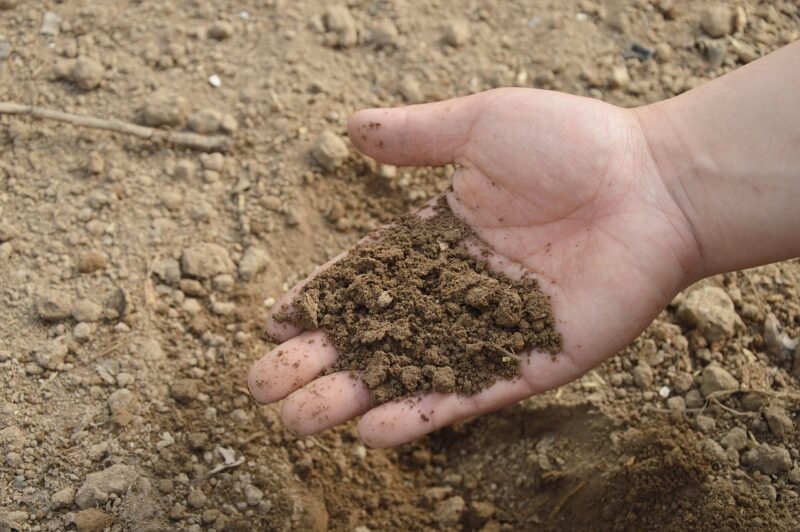Horses and mud seem to go together. If you’re a horse owner, mud can be a nightmare, especially in spring and after heavy rain. But is mud bad for horses? Is there anything good about mud for horses…and you? Or is mud something to avoid at all costs? Let’s dive into the mud, splash around, and find out whether mud is bad for horses.
What Is Mud?
To know if mud is bad for horses, we have to know what mud is. Mud is wet, sucks off your boots and stains clothes and your horse’s coat. But what’s it made of?
Mud is a mix of water and soil particles. Soils come in different types, and when they get wet, muds develop with their own unique personalities – which is why sticky clay muds from some areas look so different from squishy, loamy muds from other places.
If you scooped up mud from different paddocks and looked at it under a microscope, each one would look a little different. That’s why mud in different regions have different colors and vary in how squishy, sticky, or slippery they are.
How Is Mud Made?
Mud happens when soil meets water and becomes saturated. Some mud is natural and develops on its own, like around rivers and coastlines.
But we’re talking about whether mud is bad for horses, and that kind of mud comes from the combination of waterlogged ground and horse hooves. When wet soil is mixed and churned, deep mud develops.

Mud is caused by overuse of wet areas, such as by hooves, boots, and tires. The more traffic, the more the soil is mixed and the thicker and squishier the mud becomes.
Mud gets worse in winter and spring because there’s not as much plant growth. Plants hold onto soil and absorb water, and really help stabilize the soil during warmer months. Also, in winter, most areas receive more rain (or snow) and the water level in the soil rises.
So that’s how mud is created. But is mud bad for horses?

Is Mud Bad for Horses? It Depends
Mud is part of the environment. And mud by itself is not bad for horses. Mud isn’t poisonous or toxic, and plain ‘ole mud doesn’t isn’t a germ-fest.
With mud, the question of whether mud is bad for horses depends on how much mud you have and how much time horses have to spend in it.
Mud can be dirty, but not unhygienic. It can be inconvenient but not dangerous. But some kinds of mud can cause problems, including illness or injury. To know whether the mud on your property is bad for your equine friend, it’s important to think about what kind of mud you have, where it is, and how much control your horses have over time spend in mud.
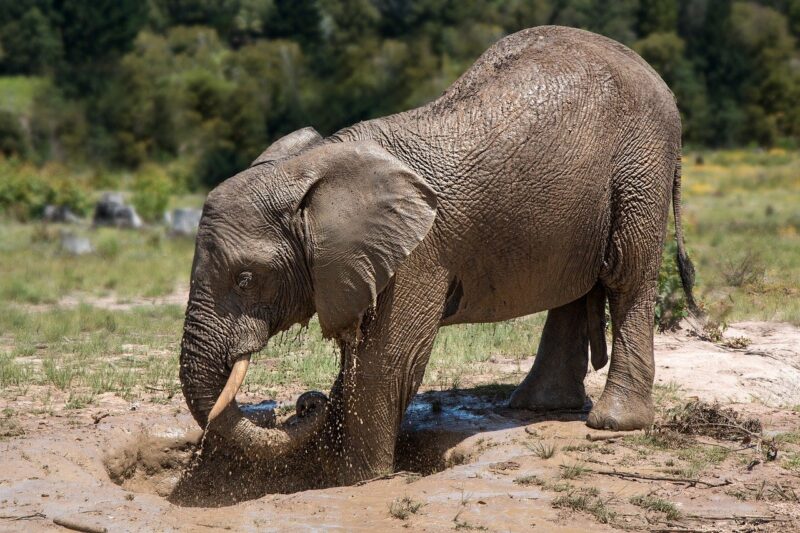
So how can mud be beneficial to horses when we often hear that muddy hooves get thrush, damp fetlocks get scratches, and a dirty coat develops rain rot?
Mud Can Be Good!
Sounds crazy, but when you dive deeper, you’ll find benefits to mud. Mud in moderation can be great for skin, coat, and mind.
The moisture from mud can be great for hooves, preventing excessive dryness. A layer of mud on the coat is perfect for cooling down on a hot day, or as armor against insects and the sun.
When mud gets to the skin, it helps gather up skin cells and other waste. When it dries and the horse rubs or shakes it off, the mud takes debris with it to freshen up the skin. If you’ve ever used a mud mask on your face or body, you’ve enjoyed the benefits of mud.
In nature, some animals even eat mud to sooth stomach upsets, protect against toxic foods, and remedy parasite problems.
But we’re always told that mud is bad for horses. Why can mud be problematic?
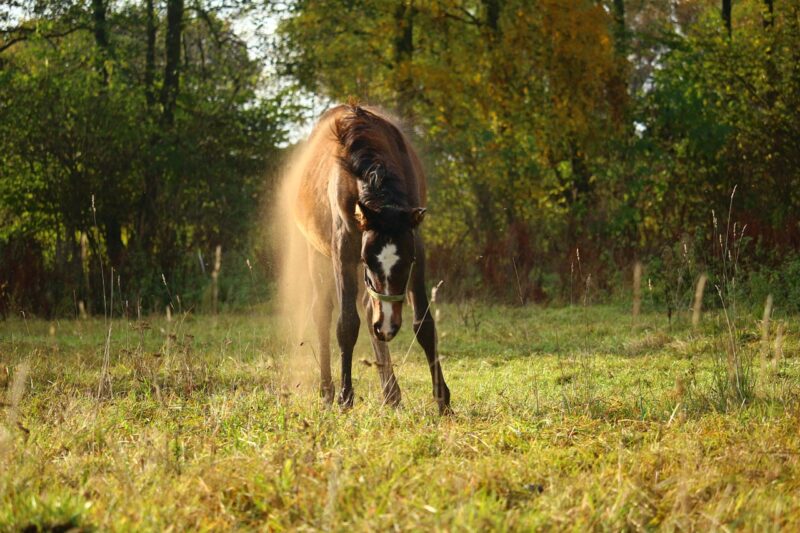
When Mud is Bad for Horses
When mud is the only option, though, the story changes. Most pasture mud is different from natural mud and horses have less choice in how much time they spend in or near mud.
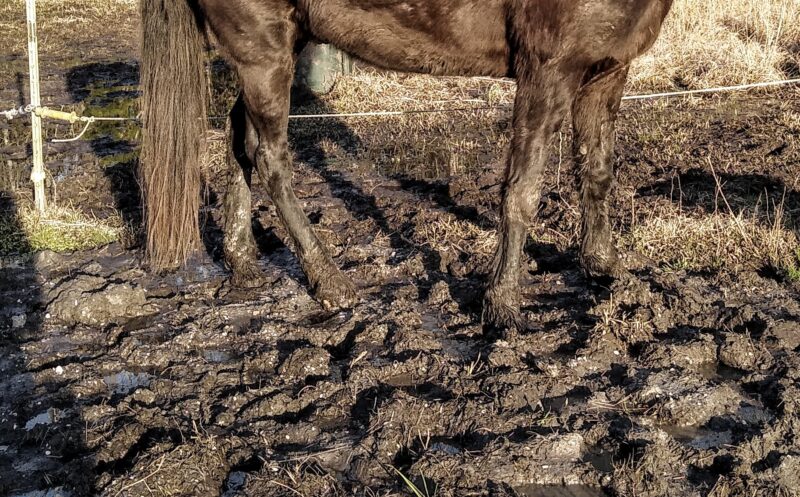
Wild horses cover a lot of ground, and don’t stand in one place long enough to churn the ground into mud. Horses in human care travel the same area over and over. Their hooves create mud near gates, feeding areas, and shelters where they spend most of their time.
The mud itself can be different, too. Mud in your horse’s pasture may not just be mud and water. It often includes fresh manure and urine, and that’s not great – this kind of mud is a home for disease organisms.

When horses have to spend a lot of time standing in mud like this, the constant moisture is bad for their skin and hooves. Bacterial and fungal problems like thrush and scratches can develop and spread in muddy conditions.
Running or even walking through deep mud can also be dangerous because of the extra strain it places on your horse’s tendons and muscles. For these reasons, mud control for horses is important.
Mud Control for Horses
It’s impossible to eliminate mud completely, but by using good mud control for horses, you can get more of the benefits and fewer of the problems of mud.
Using Horse Behavior to Control Mud
Water troughs, gates, the areas outside shelter structures, and feeding locations are the most common places that mud develops. These are the highest traffic areas in your horse’s paddock.

To reduce the amount of mud that forms in these areas, focus on your horse’s behavior. If your horse paces at gates or stands waiting for long periods, your mud control will struggle to keep up.
To help, encourage your horse to spend time in other places and get exercise in other parts of the pasture. Enrichment for horses encourages their natural behavior and is perfect for behavioral mud control. Try these strategies:
- Moving hay feeding locations regularly to rest the soil
- Using many smaller feed stations to encourage horses to move often
- Giving constant access to forage such as hay to occupy horses and discourage standing near gates
- Training the horses to wait in other areas using positive reinforcement
- Using enrichment items to reduce anxiety and mud-making behaviors like pacing
Adjusting the Horse’s Environment to Control Mud
Pasture layout and drainage improvements are the single largest step you can take to reduce mud. They work by encouraging water to drain somewhere other than your horse’s pasture.
Adding ditches, altering slope, and installing additional fill, gravel, or geotextiles are all potential mud-busting techniques. These improvements can be expensive and time-consuming, but the payoff in less muddy pasture conditions and better access to the horses will be immense.
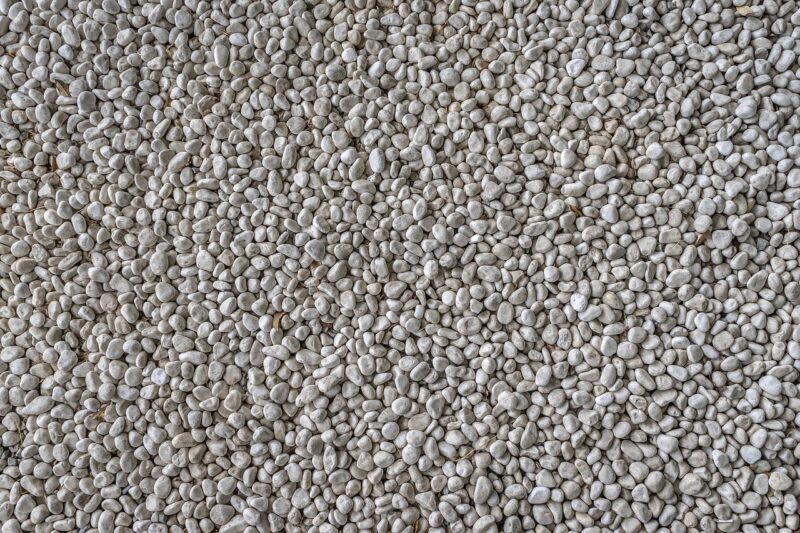
Manure management is also important. Removing manure frequently makes the mud more hygienic, and cleaner mud is less likely to be bad for horses. Regular cleaning of pastures also reduces the amount of organic matter that eventually turns into more mud.
Lastly, consider pasture space and the number of horses. Overcrowding makes it much harder to control mud. Healthy pastures that aren’t overgrazed or trampled make less mud, to do your best not to keep too many horses on the land available.
How Mud Can Be Good For Horses
Remember, not all mud is bad for horses! When your horse has the choice to experience mud, they can get the benefits without the drawbacks.
In the wetter parts of the year, there will probably be plenty of natural mud around even in well-designed pastures. This is ideal because the horse can use the mud whenever they feel like it.

In the summer or other dry periods, you can offer mud enrichment on a regular schedule. There are a few things you can try out to give your horse a mud experience:
- Fluff a patch of bare soil with a rake, and spray generously with a hose or drain a trough to create a temporary mud patch.
- Bring in a load of topsoil to create a permanent “squish zone” for mud enrichment – perfect if you have dry, arid pastures.
- Take your horse on a sensory walk to a muddy place and let them sniff, paw, or even roll in the mud.
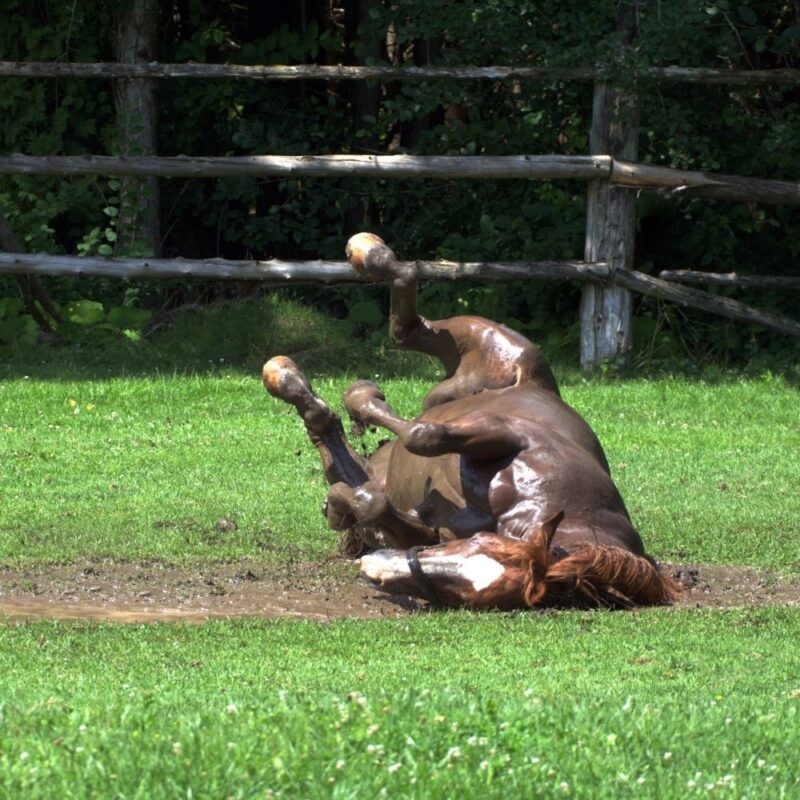
The Takeaway: Is Mud Bad For Horses?
Mud doesn’t have to be bad for horses, but our equine friends have more mud time than their wild ancestors. This can turn mud from good to harmful. To keep mud from being bad for your horse, it’s important to provide good mud control.
Too much mud can harm your horse’s skin, hooves, and limbs. But mud is enriching and can have benefits, so manage your mud and enjoy the sight of muddy ponies fresh from a good roll in a mud puddle: just the way nature intended.
